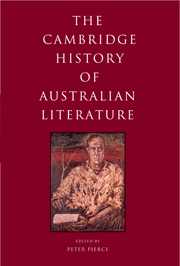Book contents
- Frontmatter
- Introduction
- FROM EUROPEAN IMAGININGS OF AUSTRALIA TO THE END OF THE COLONIAL PERIOD
- FROM THE LATE NINETEENTH CENTURY TO 1950
- TRAVERSES
- FROM 1950 TO NEARLY NOW
- 17 Publishing, patronage and cultural politics: Institutional changes in the field of Australian literature from 1950
- 18 Theatre from 1950
- 19 The short story since 1950
- 20 Scribbling on the fringes: Post-1950 Australian poetry
- 21 Groups and mavericks
- 22 The challenge of the novel: Australian fiction since 1950
- 23 The novel, the implicated reader and Australian literary cultures, 1950–2008
- 24 Nation, literature, location
- Select bibliography
- Index
- References
17 - Publishing, patronage and cultural politics: Institutional changes in the field of Australian literature from 1950
from FROM 1950 TO NEARLY NOW
Published online by Cambridge University Press: 28 May 2011
- Frontmatter
- Introduction
- FROM EUROPEAN IMAGININGS OF AUSTRALIA TO THE END OF THE COLONIAL PERIOD
- FROM THE LATE NINETEENTH CENTURY TO 1950
- TRAVERSES
- FROM 1950 TO NEARLY NOW
- 17 Publishing, patronage and cultural politics: Institutional changes in the field of Australian literature from 1950
- 18 Theatre from 1950
- 19 The short story since 1950
- 20 Scribbling on the fringes: Post-1950 Australian poetry
- 21 Groups and mavericks
- 22 The challenge of the novel: Australian fiction since 1950
- 23 The novel, the implicated reader and Australian literary cultures, 1950–2008
- 24 Nation, literature, location
- Select bibliography
- Index
- References
Summary
The period from the end of World War II has seen at least three major transformations of the Australian literary field. In the 1950s, cultural institutions dedicated to Australian literature or Australian books were still relatively underdeveloped, while publishing and bookselling operated within an established set of relationships with the British publishing industry. In the decade from the late 1950s, local publishing of Australian books expanded, gradually at first, and then rapidly as local branches of British firms developed Australian lists. New and more diverse institutions dedicated to Australian books and authors emerged, as did a generation of writers and readers with new orientations towards both literature and the nation. By the mid-1970s Australian literature was defined through a set of relatively autonomous institutional sites in universities, publishing, criticism, bookselling and professional associations. The presence of contemporary books expanded dramatically, and for the first time something like the literary heritage was available to contemporary readers through numerous reprint series and an increasingly rich critical literature. In the new century, however, some of these achievements seem less secure. Although a mature infrastructure has been established, it exists within a newly globalised international literary system that poses once again some of the recurrent questions for Australian culture: its independence, its national significance, and the role of literature (or books and reading) in those equations.
The literary field
The terms literary ‘field’ and literary ‘system’ refer to the network of cultural institutions, industry structures, professional identities, public policies and social practices that determine how books get to readers and how readers get to books or to any other source of literature and literary talk. They include publishing and bookselling; magazines and book reviews; libraries, schools and universities; professional bodies like the Australian Society of Authors; editors and literary agents; informal associations such as writing and reading groups; and the literary festivals and prizes that have become a feature in the national literary landscape since the mid–1990s.
- Type
- Chapter
- Information
- The Cambridge History of Australian Literature , pp. 360 - 390Publisher: Cambridge University PressPrint publication year: 2009
References
- 4
- Cited by

